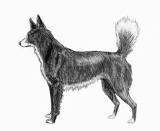
Tahltan Bear Dog
Encyclopedia
The Tahltan Bear Dog was a breed
Dog breed
Dog breeds are groups of closely related and visibly similar domestic dogs, which are all of the subspecies Canis lupus familiaris, having characteristic traits that are selected and maintained by humans, bred from a known foundation stock....
of dog
Dog
The domestic dog is a domesticated form of the gray wolf, a member of the Canidae family of the order Carnivora. The term is used for both feral and pet varieties. The dog may have been the first animal to be domesticated, and has been the most widely kept working, hunting, and companion animal in...
that was indigenous to Canada
Canada
Canada is a North American country consisting of ten provinces and three territories. Located in the northern part of the continent, it extends from the Atlantic Ocean in the east to the Pacific Ocean in the west, and northward into the Arctic Ocean...
. This breed is believed to be extinct by most authorities.
Appearance
The Tahltan was built somewhere between the lines of the spitzSpitz
Spitz-type dogs are a type of dog, characterized by long, thick, and often white fur, and pointed ears and muzzles...
and pariah
Pariah dog
The term pariah dog originally referred to Chinese/Indian feral dogs of a particular type, but it is now used by the United Kennel Club to refer to a purebred dog category.- Feral dogs of India :...
types. The ideal dog was, above all else, athletic and agile
As they were always bred solely for hunting value, appearance could vary significantly between dogs.
Coat and colour
A Tahltan Bear Dog was primarily black, dark brown or blue (lead), with some white patches on the chest and sometimes the feet. Standing 14 to 17 inches high at the shoulder, with relatively large, erect pointed ears, with a refined, pointed muzzle. The glossy coat was of average length, with guard hairs covering a thicker undercoat. Paws some what webbed and relatively large for the size of the dog. They were also double jointed and gaited, enabling them to switch gaits as they moved through different terrain or heavy brush, as all the aboriginal dogs of the north and South American continents; were bred for their ability to change gaits to adapt to different terrains or distancesLike others of their group, they had a peculiar yodel. Foxy in appearance, their main distinction among dogs is their novel tail. Short, bushy and carried erect, it has been described variously as a shaving brush or a whisk broom.
History
Raised by the Tahltan Natives to hunt bear, the Tahltan Bear Dog was a mighty power in a small package. Before a hunt, the dogs were ceremonially bled by stabbing them in the hindquarters with the fibula bone of a fox or wolf. The morning of the hunt, two dogs were carried in a sack over the Natives shoulder until fresh bear tracks were sighted. Upon release, these little dogs moved lightly over the crust of snow while the bear was slowed down by the deep drifts. Their fox-like staccato yaps harassed the bear into submission or confused him until the Natives could come close enough for a kill. To prepare for a foray against big cats, a claw from a dead lynx was used to ceremonially mark the dog's face.The Tahltan Bear Dog had the courage to face a bear, but was friendly and gentle with smaller
animals and with humans. They lived in the tent with the family, sharing bed and board.
Descended from pariah-type dogs that had come with prehistoric migrations, the Tahltan Dogs were centralized in the remote mountainous areas of northwestern British Columbia
British Columbia
British Columbia is the westernmost of Canada's provinces and is known for its natural beauty, as reflected in its Latin motto, Splendor sine occasu . Its name was chosen by Queen Victoria in 1858...
and the Southern Yukon
Yukon
Yukon is the westernmost and smallest of Canada's three federal territories. It was named after the Yukon River. The word Yukon means "Great River" in Gwich’in....
. Their usual diet was small bits of birds, meat and fish, and they flourished in the bitter cold. Outside their native environment, they succumbed to distemper, heat prostration and problems due to dietary changes. As white explorers came into the territory, bringing a variety of other dogs, the Tahltan Dog became diluted.
Although some present-day hunting dogs in the region descend from Tahltan Bear Dogs, they are considered extinct as a breed.

